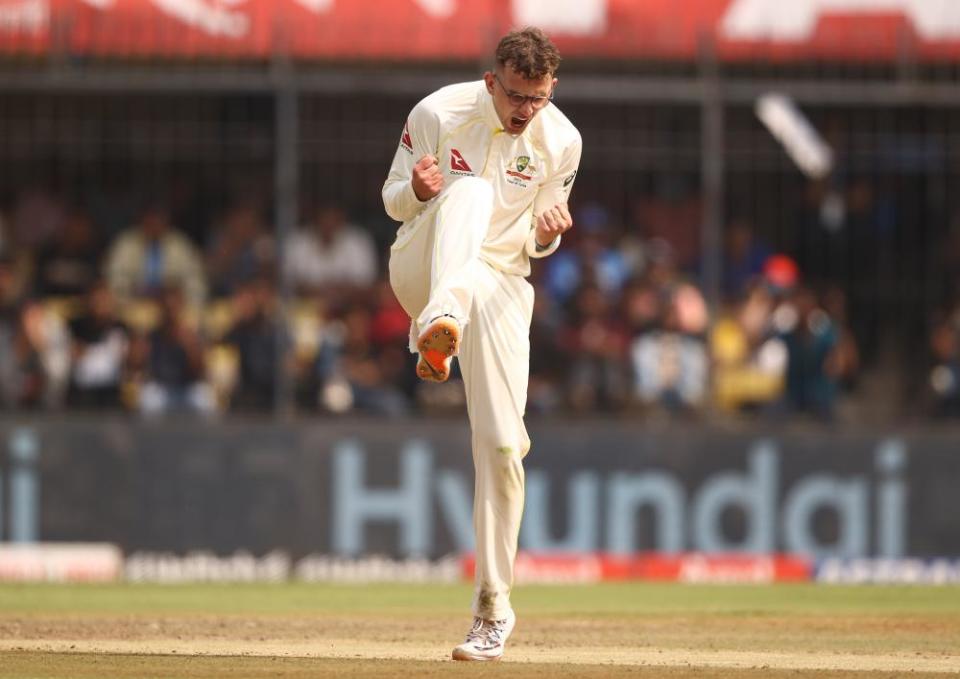
For a day, at least, the tables turned. To this point Australia’s tour of India had been marked for the visitors by two batting collapses under the scrutiny of spin: one when the first Test was almost gone, the next when the second Test was very much in their keeping. To begin the third match in Indore, though, with one last chance to stay in the series, the Australians found themselves able to out-India India.
A couple of early wickets, a pitch as even-tempered as post-midnight Gary Busey, and suddenly there were shivers running through the home side instead of their unfortunate guests. The first nine wickets fell to spin until a mad run-out on 109. The Australian reply also met difficulty, but reached stumps with six wickets in hand and a lead of 47 that could be worth far more than it sounds.
Related: Australia skittle India for 109 to dominate first day of third Test
The opening exchanges looked like the match would skew the other way. Rohit Sharma has been India’s best bat on turning pitches in recent years. Mitchell Starc returning from injury sent down the new ball at full pace and on line. His first ball took Rohit’s edge to the keeper. His fourth hit the pad in front of off stump. Neither was given out, neither was reviewed, both would have been overturned.
Usually when a team is outmatched, missing one or two scant opportunities is the end. The other team steams away. As Rohit and Shubman Gill responded with six boundaries in the next 23 balls, lashing Starc and Cameron Green through the off side, that scenario was playing out. Until spin in the sixth over changed everything.
Matthew Kuhnemann was entrusted first, having opened in both innings on debut the previous week in Delhi. The left-arm spinner was chosen for accuracy, but it was variety that brought him into the game, hurrying Rohit before slowing up the last ball of the over. Rohit jumped out and aimed for Indore’s blue and yellow bucket seats. On most grounds he would have been close enough to the pitch of the ball. Here it turned savagely past his edge, wicketkeeper Alex Carey taking it above his shoulder yet still with time for the stumping.
Suddenly the gout of soil dislodged by one delivery in the first over had more bearing on the match than the wicket chances missed. Starc got one more over. Subtler turn from Kuhnemann took Gill’s edge to Smith at slip. The opening partnership of 27 had become two for 34. Off-spinner Nathan Lyon promptly replaced Starc, spin at both ends.

Already balls had turned sharply, stayed down, or jumped from a length, far more extreme on day one than the surfaces in Nagpur or Delhi. Cheteshwar Pujara got equally jumpy in a way that belied his 101 Tests, backing away to force Lyon square after three balls. Instead he lost his stumps to one that scuttled through so low that it redefined grassroots cricket. Ravindra Jadeja’s promotion to No 5 came and went, slapping Lyon to short cover.
Shreyas Iyer threw the bat at width, under-edging past off stump with enough contact to dislodge a bail. Kuhnemann had three, India were 45-5. After handling the conditions better than anyone for 22 out of a partnership of 25, Virat Kohli met his mini-nemesis Todd Murphy, the third-gamer floating an off-break from around the wicket, beating Kohli in the air, and turning it enough to hit pad past his inside edge while going straight enough for leg stump.
It was the point of the innings where India’s lower middle order usually bail them out, but the all-rounders had to fail with the bat eventually. Two smart reviews found wicketkeeper KS Bharat lbw to Lyon despite a big stride, then Ravichandran Ashwin nicking a pearl from Kuhnemann. The left-armer’s fifth came after Umesh Yadav lumped a couple of sixes, before being struck so concretely in front that he walked straight off with one wicket remaining and two reviews in hand.
Seeing India taken apart, Australia’s reply was not without nerves about handling the conditions themselves, especially after Travis Head went for nine. But a combination of Usman Khawaja’s otherworldly skill and Marnus Labuschagne’s otherworldly luck put on 96 together. Khawaja was chanceless in his 60, playing with the softest of hands. Labuschagne was bowled by a no-ball, not out to a certain lbw that was not reviewed, and dropped by the keeper on his way to 31.
For the first time in the series, with a worried eye on the scoreboard, Ashwin and Jadeja strained to attack. Over-pitching offered runs or a safe defence. Jadeja did chip away for all four wickets to fall, with Steve Smith caught behind for 26 before stumps. Smith determinedly played the line of the ball as he did so successfully in 2017, but got unlucky as it took his edge rather than beating it.
With Australia’s modest lead, normal service could resume on day two with India wrapping them up. Or if Peter Handscomb and Cameron Green survive an hour or two, Australia’s advantage could be decisive. Either way, like Pune in 2017, India got a taste of what it’s like to play India. Those spinning pitches can’t always break in your favour.
Article courtesy of
Source link